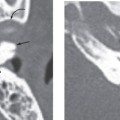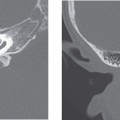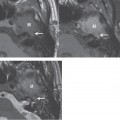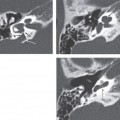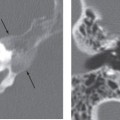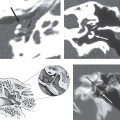CHAPTER 17 Persistent Stapedial Artery
Epidemiology
Persistent stapedial artery (PSA) is a rare congenital vascular anomaly of the middle ear. The prevalence of PSA is 0.02 to 0.05% in surgical series, and it was slightly higher (0.48%) in a temporal bone study.
Clinical Features
The majority of patients are asymptomatic. Rarely, PSA may result in pulsatile tinnitus, conductive hearing loss, or a pulsatile retrotympanic red mass.
Pathology
The stapedial artery arises at 4 to 5 weeks of fetal life from the hyoid artery and connects branches of the future external carotid artery to the internal carotid artery. The hyoid artery is a derivative of the second branchial arch, near its origin from the proximal internal carotid artery (third branchial arch). It extends cranially and passes through the mesenchymal primordium of the stapes (second branchial arch) and forms the obturator foramen of the stapes. The stapedial artery gives rise to two branches after entering the cranial cavity. The upper, or supraorbital, branch becomes the middle meningeal artery and transiently anastomoses with the ophthalmic artery. The lower, or maxillomandibular, division has two branches: mandibular and infraorbital. This lower division leaves the cranial cavity via the foramen spinosum. Normally, anastomoses develop between the ventral pharyngeal arteries (roots of adult external carotid artery) and the lower division branches of the stapedial artery, which involutes during the 10th week of fetal life with reversal of flow at the foramen spinosum level. When the artery fails to involute in the 3rd fetal month, a persistent stapedial artery results. It is usually seen with an aberrant internal carotid artery or other middle ear anomalies, especially of the stapes and facial nerve, and may be bilateral. Other associations with trisomy 13, 15, and 21, otosclerosis, anencephaly, Paget disease, and neurofibromatosis have been reported.
Treatment
Stay updated, free articles. Join our Telegram channel

Full access? Get Clinical Tree


